Brpady Dfined Is the Art of Implemting That Leaves Mark on a Surface

Extensive Marine Heatwaves at the Bounding main Surface in the Northwestern Pacific Ocean in Summer 2021
ane
Fisheries Resources Institute (Kushiro), Japan Fisheries Research and Teaching Agency, Kushiro 085-0802, Hokkaido, Japan
2
Fisheries Resource Institute (Yokohama), Nihon Fisheries Enquiry and Educational activity Agency, Yokohama 236-8648, Kanagawa, Nihon
*
Author to whom correspondence should be addressed.
Academic Editors: Chung-Ru Ho, Antony Chiliad. Liu and Xiaofeng Li
Received: 6 September 2021 / Revised: 1 Oct 2021 / Accepted: three Oct 2021 / Published: 5 October 2021
Abstract
In July–August 2021, intense marine heatwaves (MHWs) occurred at the ocean surface over extensive areas of the northwestern Pacific Bounding main, including the entire Body of water of Japan and part of the Sea of Okhotsk. In extent and intensity, these MHWs were the largest since 1982, when satellite measurements of global sea surface temperatures started. The MHWs in summer 2021 were observed at the sea surface and occurred concomitantly with a stable shallow oceanic surface boundary layer. The distribution of the MHWs was strongly related to estrus fluxes at the body of water surface, indicating that the MHWs were generated mainly by atmospheric forcing. The MHWs started to develop after effectually 10 July, concurrent with an farthermost due north shift of the atmospheric westerly jet. The MHWs adult rapidly under an atmospheric high-pressure level organization nearly the body of water surface, associated with a northwestward expansion of the Due north Pacific Subtropical High. The MHWs exhibited peaks around 30 July to one August. Subsequently, post-obit the southward deportation of the westerly jet, the MHWs weakened so shrank abruptly, synchronously with rapid deepening of the oceanic surface boundary layer. Past 18 August, the MHWs had disappeared.
1. Introduction
As generally divers, an extreme consequence occurs when the values of a weather or climate variable either exceed a threshold near the upper end of an observed range, or are lower than a threshold well-nigh the lower stop [1]. Many extreme weather condition and climate events effect from natural climate variability, only some extreme events have occurred as a result of anthropogenic climate change and ongoing global warming (e.one thousand., [ii,iii,4]). Marine heatwaves (MHWs) are an example of an extreme climate in an oceanic system [v,half dozen,7]. In the final century, from 1925 to 2016, the global average frequency and elapsing of MHWs increased by 34% and 17% respectively, resulting in a 54% increase in annual marine heatwave days [8]. According to Oliver [9], an increase in mean body of water surface temperature (SST), rather than its variability, has been the ascendant driver of the increasing frequency of MHW days over approximately two-thirds of the world'south body of water, and it has been the ascendant commuter of changes in MHW intensity over approximately one-third of the sea. Moreover, it has been projected that these historical trends in MHW properties will continue over the coming decades nether global warming caused past anthropogenic climate modify [10]. Furthermore, MHWs accept devastatingly affected marine ecosystems in the past, and they are expected to practise so in the future, through sharp changes in biological habitat, bloodshed, reproduction, customs structure, and so on [ten,11,12,13,xiv,15].
Most published studies of MHWs in the Northward Pacific Ocean have investigated conditions in northeastern waters. A MHW known as "the hulk," which occurred persistently in 2014–2016 in the northeastern Pacific, is particularly famous (e.grand., [sixteen]). In contrast, a search for studies conducted in the northwestern Pacific, especially east of Japan, with the keyword "MHW," yielded only iii scientific studies [17,18,19]: i conducted in subtropical waters [17] and the others in subarctic waters [18,nineteen]. Miyama et al. [18] reported the occurrence of MHWs in summer during 2010–2016 nigh Hokkaido, northern Japan, which they attributed to warm mesoscale eddies that had go detached from the subtropical Kuroshio Extension and had been advected into the subarctic Oyashio region every summer of that period. These MHWs, which were localized off Hokkaido, also afflicted the social economy through their furnishings on fisheries, at to the lowest degree, for instance, angling grounds of Pacific saury shifted farther offshore [xx], and the take hold of of yellowtail in coastal waters by stock-still angling nets increased [18].
Extensive and intense MHWs occurred in July–Baronial 2021 over the northwestern Pacific, including the entire Sea of Nihon and function of the Bounding main of Okhotsk. In extent and intensity, these MHWs were the largest since 1982, when satellite measurements of global sea surface temperatures (SSTs) started. Equally the first scientific report, this study aims to describe features of these MHWs together with the accompanying atmospheric atmospheric condition and to promote future studies.
two. Materials and Methods
We analyzed gridded "Merged satellite and in situ data Global Daily Bounding main Surface Temperature" (MGDSST) datasets, comprising data from 1 January 1982 to 31 August 2021. These datasets, which were compiled past the Japan Meteorological Agency, have a spatial resolution of 0.25° (latitude) × 0.25° (longitude) and a daily temporal resolution [21].
We also used the "Roemmich-Gilson Argo Climatology," a global monthly dataset of seawater temperature in the subsurface created by the Scripps Institute of Oceanography [22] with a horizontal resolution of i° (latitude) × 1° (longitude). We included data from Jan 2004 to July 2021 in our analysis.
Nosotros likewise used global atmospheric products at multiple vertical levels from the Japanese 55-year Reanalysis dataset (JRA-55), the second global atmospheric reanalysis project of the Japan Meteorological Agency [23]. These information have a horizontal resolution of 1.25° (latitude) × i.25° (longitude). In our assay, we used three-hourly or six-hourly outputs for the flow from 1 January 1990 to 31 August 2021.
To infer the oceanic surface boundary layer conditions during the catamenia of MHWs in 2021, numerical experiments were conducted with realistic ocean circulation models that are part of the operational bounding main forecast system of the Japan Fisheries Research and Education Agency, "FRA-ROMS" [24]. The ocean circulation models, which are based on the Regional Sea Modeling Organisation (ROMS) [25,26,27], consist of a ane/two° resolution parent model for the North Pacific and a 1/10° resolution kid model for the northwestern Pacific, continued by one-way nesting to simulate dominant basin-scale and mesoscale variations around Japan [28]. Daily mean reanalysis data for i July 2021, assimilated past using a three-dimensional variational scheme, were utilized for the initial conditions of two-month hindcast and sensitivity experiments conducted without further information absorption. To sequentially estimate momentum and heat fluxes at the sea surface during each model run, 31 sets of atmospheric elements near the sea surface (i.east., wind vectors at ten m, air temperature and specific humidity at 2 g above the sea surface, air pressure, precipitation, and net shortwave and down longwave radiation at the sea surface) were derived from the 3-hourly outputs of the JRA-55 system for July–August of 1990–2019 and 2021.
Climatological daily means were estimated for each element (e.k., SST, air temperature, sea level pressure), except subsurface ocean temperature, past averaging their data for 1990–2019. This thirty-year averaging period, which was selected by referring to Hobday et al. [5], does not include the 1980s, during which a typical cold SST government prevailed effectually Japan. Therefore, because the climatological averaging period excluded data from the 1980s, MHWs in recent years were less frequently detected than would accept been the case had the selected climatological period included the 1980s. Further, because of express data availability, climatological monthly ways of the Argo-based subsurface bounding main temperature were estimated by averaging data over just xv years (2004–2018) instead of 30 years. Throughout this report, an anomaly was defined as a difference from the climatological mean.
The MHWs were detected from daily SST data and categorized according to intensity following Hobday et al. [half-dozen]. Intensity categories were defined based on the SST difference, Tdiff, between the 30-yr climatological average (Tavg) and the 90th percentile value for each grid point. If the SST on a given 24-hour interval was ≥(Tavg + N × Tdiff) and <(Tavg + (N + i) × Tdiff), it was categorized into intensity category N. In addition, the MHW index was divers every bit (SST – Tavg)/Tdiff. Note that in this newspaper, the duration of MHWs is referred to as their age.
3. Results
3.1. Surface Ocean Conditions
3.i.ane. Ocean Surface Temperatures
Figure 1a,b show intensity and age respectively, of MHWs on 30 July 2021, when the MHWs were at their maximum strength and extent, as explained later. The MHWs in the northwestern Pacific occurred within a zonal band, between 38°Northward and 50°Due north and extending from 120°East to 170°West, including the marginal seas, that is, the northern part of the Yellow Body of water, the whole of the Sea of Japan, and the southern half of the Ocean of Okhotsk. The MHW intensity on xxx July was classified into categories i–4. Some areas of the MHWs corresponded to big SST anomalies > 6 °C (Figure 1d). The MHWs exhibited maximum intensity (i.eastward., category iv) on thirty July in the northern part of the Sea of Japan and tended to weaken gradually toward the due east. The age of the MHWs in the northwestern Pacific on 30 July was inside 1–xxx days: it was longest (~30 days) in the northern part of the Sea of Japan and tended to exist shorter further east.
It is worth noting that intense MHWs appeared to start on the northwestern shelf of the Sea of Okhotsk around 10 July 2021 and subsequently aggrandize from there (Figure 1c,d). Nevertheless, the SST data analyzed in this report did not strictly discriminate betwixt SSTs in the presence or absence of bounding main ice; thus, if sea ice remained on the northwestern shelf at the beginning of summer, the estimated MHWs would include large uncertainties. Therefore, whether the above feature is a existent phenomenon is questionable.
We focused on MHWs eastward of Japan in the northwestern Pacific and excluded from our analysis the Bounding main of Japan, where MHWs that were more intensive than those in 2021 occurred locally afterward 1982 (eastward.g., Jan 2020). Thus, we estimated daily fourth dimension series of SST anomalies and the MHW alphabetize averaged over the rectangular area within 143°E–180° and 40°–fifty°N (Figure 2). Both time series show historical maxima in July–August 2021 (Figure 2a). The spatial hateful of the daily MHW index exceeded ane.0 on a total of 207 days during 1982–2021, and 23 of these days were in July–August 2021. The spatial mean too exceeded ane.5 on 15 days during 1982–2021, of which 14 were in July–August 2021. These results signal that the MHWs in summer 2021 were the almost intense and all-encompassing in the northwestern Pacific during the concluding four decades.
The transition to MHWs in summer 2021 can exist interpreted as follows (Figure 2b). The MHWs started to develop on around 10 July 2021 (Effigy 1c), when the spatial hateful SST anomaly was close to zero (Figure 2b). The MHWs reached maximum intensity and extent effectually thirty July to ane August (Effigy 1d), and then immediately started to weaken. By 18 August (Figure 1e), the spatial hateful SST bibelot was once more near zero (Figure 2b) and the MHWs had almost entirely disappeared.
3.one.2. Heat Fluxes at the Sea Surface
Cyberspace estrus flux anomalies at the sea surface during x–30 July 2021 were mostly positive inside the focal expanse, that is, the central surface area of MHWs (Figure 3a); thus, the sea surface was heated by the atmosphere, relative to the climatology. The distribution of net heat flux anomalies (Figure 3a) also correlated with that of SST anomaly differences between 10 and xxx July (Figure 3b) (r = 0.69), suggesting that the MHWs were attributable primarily to increased cyberspace heat fluxes at the sea surface over the northwestern Pacific.
The internet heat fluxes were decomposed into four components: net shortwave radiations, net longwave radiation, latent heat, and sensible heat (Figure 4). Within our focal expanse, net shortwave radiation anomalies exhibited three positive maxima, centered around (145°E, 40°North), (170°E, 40°N), and (160°E, 45°Due north) (Figure 4b). These three positive maxima corresponded spatially to iii negative minima of the full cloud encompass and low cloud comprehend anomalies (see Section three.3.1). Further, the spatial patterns of positive and negative net shortwave radiation anomalies in the focal expanse (Effigy 4b) were roughly contrary to those of the other 3 components (Figure 4d,f,h), indicating that negative net shortwave radiation anomalies in the focal surface area were compensated past positive anomalies of the other three components. As a result, net heat flux anomalies at the sea surface were positive over the surface area of MHWs (Figure 3a).
Note that positive anomalies of net longwave radiation and sensible heat around the focal area (Effigy 4d,h) corresponded to positive values of the respective components (Figure 4c,g). The positive values thus point that the sea surface was actually heated. Although MHWs with loftier SSTs were expected to cause big upwards longwave radiation (i.e., negative estrus fluxes), the net longwave radiation was nevertheless positive in some areas within the MHW area, for example, around the northwestern corner of the focal area (Effigy 4c). This result suggests that potent downwardly longwave radiations from clouds exceeded the large upward longwave radiation from the bounding main surface. In fact, as described in Section 3.3.1, dense clouds tended to cover areas with positive net longwave radiation (Figure 4c). In whatever example, it should be emphasized that at that place were inter-regional differences in the origin of positive net heat flux anomalies over the area of MHWs; that is, the SST heating process differed inter-regionally inside the expanse of MHWs.
three.ii. Subsurface Sea Weather
3.2.1. Subsurface Sea Temperatures
In July 2021, temperatures in the subsurface at 20 m depth, just below the oceanic surface boundary layer, exhibited positive anomalies, mostly over the whole of the focal surface area (Effigy 5c), although relatively large positive anomalies (>1 °C) were limited to its southern half. These relatively large positive anomalies were also distributed continuously after March 2021 (e.g., Figure 5a–c). In addition, subsurface temperatures at 20 g depth spatially averaged over the focal area reached a local maximum not in July 2021 just in May 2021 (Effigy 5d), after which they decreased slightly until July 2021. Moreover, the positive anomalies in July 2021 were non the largest during 2004–2021. These features of the subsurface temperature were thus clearly dissimilar from the corresponding SST features. Hence, the chief factors controlling the positive temperature anomalies in July 2021 seemed to differ between 20 m depth and the sea surface, and the MHWs that developed dramatically in summer 2021 were mostly express to the sea surface (<xx chiliad depth). With respect to this point, however, the positive subsurface temperature anomalies apparent after March 2021 might have contributed to the formation or maintenance of stratified conditions in the oceanic surface purlieus layer in July 2021, as described in the next section.
3.2.2. Oceanic Surface Purlieus Layer
In this study, the depth of the oceanic surface boundary layer, defined equally the shallowest depth where the bulk Richardson number is equal to its critical value, was derived from model simulations instead of the more conventional mixed layer depth (i.eastward., the depth at which the h2o density in the upper layer exceeds a threshold value, typically 0.125 kg m−3, relative to the 10 m density), primarily because the mixed layer was very thin during summer 2021 and could not exist accurately evaluated past the conventional mixed layer depth.
Hindcast and sensitivity experiments conducted with realistic ocean circulation models revealed that thickness anomalies of the oceanic surface boundary layer during 10–xxx July 2021 were mainly negative within the focal surface area, except for an area of positive anomalies that extended southwest–northeast, from (165°E, forty°N) to (180°, 46°Due north) (Effigy 6a). The thickness of the oceanic surface boundary layer remained pocket-sized in the focal expanse during the period from 13 July to 5 August 2016 (Figure 6b), during about of which MHWs were quickly developing (Effigy 2b). From 7 August, notwithstanding, the thickness increased abruptly, at the same time that the MHWs were weakening chop-chop (Effigy 2b). These results suggest that positive internet heat fluxes (Figure 3a) and relatively weak wind stress (equally explained in Department three.three.ane) near the sea surface stably maintained strong stratification, suppressed vertical convection, and accelerated the SST increment, that is, the rapid evolution of MHWs.
3.three. Atmospheric conditions
iii.3.ane. Conditions Near the Sea Surface
Bounding main level pressure anomalies during 10–30 July 2021 were widely positive in the northwestern Pacific, except in the northern Sea of Okhotsk and the western Bering Sea (Figure 7b). These positive anomalies were attributable to a northwestward expansion of the Due north Pacific Subtropical High (Figure 7a). The distribution of sea level pressure anomalies was besides similar to MHW distribution (Effigy 1a), although the distribution of air temperature anomalies near the sea surface (Effigy 7c) more closely resembled the MHW distribution (Figure 1a). Local maxima of the air temperature anomalies exceeded 3 °C.
As mentioned in Department 3.ane.ii, the distributions of positive and negative anomalies of full and low cloud embrace (Figure 7e,f) were almost opposite to those of positive and negative net shortwave radiation anomalies (Figure 4b). In add-on, in the focal area, the positive anomalies of full and low deject cover (Figure 7e,f) corresponded to both positive values and positive anomalies of net longwave radiation (Figure 4c,d), where stiff downward longwave radiation from clouds to the sea surface exceeded the large upward longwave radiation attributed to MHWs. Moreover, as mentioned in Section iii.2.ii, negative or small positive (<0.02 Pa) wind stress magnitude anomalies were distributed in the western half of the focal expanse (Figure 7d). In contrast, in the eastern one-half of the focal expanse, relatively large positive anomalies (0.02–0.06 Pa) were distributed in an area extending from southwest to northeast, corresponding to the area of positive oceanic surface purlieus layer anomalies (Figure 6a).
3.3.ii. Variation of the Westerly Jet at 200 hPa
Here, we focus on the westerly jet variation at 200 hPa every bit a potential driver or trigger of the atmospheric variations and MHWs in summertime 2021. Maps of eastward wind velocity at 200 hPa averaged over 10–30 July (Figure 8a) revealed that the strong e wind (>twenty k s−1) associated with the westerly jet [29] migrated northward, largely to the north of Japan, and skirted the focal area. The position of the velocity maximum reached 55°Due north at around 140°E. The velocity maximum betwixt 120°Eastward and 180° during 10–30 July 2021 was clearly located north of the climatological mean position (Effigy 8b).
The n shift of the westerly jet began suddenly at the commencement of July: large northward shifts of the westerly jet to the north of 50°N started at 70°E on 5 July, propagated eastward, and reached 120°–140°Eastward around Nippon on 11–15 July (Effigy 9a). After 15 July, the meridional position of the jet in 143°East–180° stayed north of 50°N until the beginning of Baronial, although it was intermittently disturbed (due east.thou., by typhoon events in late July): fifty°N corresponded to the northern boundary of the MHWs in the northwestern Pacific (Effigy 1a). After around i–8 August, the axial position of the jet was displaced to the south. Simultaneously, the MHWs in the northwestern Pacific started to weaken and compress.
The large northward shift of the westerly jet identified in early on to mid-July exceeded the climatological mean plus three standard deviations (Figure 9b); therefore, it was interpreted as a rare event. This result suggests that the abnormally large northward shift of the westerly jet triggered warm atmospheric conditions almost the sea surface and thus caused the strongest, near all-encompassing MHWs all the same recorded over the northwestern Pacific.
4. Discussion
In this article, we reported on the most extensive and intense MHWs in the historical record of the last 40 years, which occurred in the northwestern Pacific during July–August 2021. Notwithstanding, nosotros mainly express our caption to certain features: SST, the oceanic surface purlieus layer, heat flux at the sea surface, and atmospheric conditions. We just briefly mentioned the redistribution of heat from the ocean surface to the sea subsurface by bounding main advection and diffusion. In addition, although differences in SST anomalies were positively correlated with net oestrus flux anomalies (r = 0.69, Figure three), anomalies of SST and net heat flux were not strongly correlated with each other. In considering these bug, the uncertainties of the SST and oestrus flux data should first of all be meticulously validated by comparing dissimilar datasets with each other and with in situ data (e.m., surface buoy and vessel data). Moreover, it should exist noted that the core area of the MHWs was at 43°–46°Northward (not shown), whereas the net oestrus flux anomalies did not show respective maxima at 43°–46°N. Additionally, every bit described in Section 3.one.2, SST heating processes differed inter-regionally within the area of MHWs. Hence, we anticipate that a feedback process from the ocean to the atmosphere contributed to localized enhancement of MHWs. Air–sea processes that might be involved in the enhancement of MHWs at mid-latitudes include SST–cloud feedback (due east.g., [30,31,32]), surface heat flux feedback dominated by turbulent flux (e.g., [33]), or an air–sea process related to the imbalance between incoming and approachable fluxes through the bounding main surface (due east.one thousand., [34]). A useful first step to clarify such processes would exist to conduct numerical experiments with a coupled air–body of water model.
In this article, we too focused mainly on the development of MHWs in the northwestern Pacific, only the MHWs likewise decayed quickly after the westerly jet was displaced southward at the first of August 2021. Therefore, we provide hither a brief clarification of atmospheric atmospheric condition near the bounding main surface during ane–18 August 2021. In this flow, the Due north Pacific Subtropical High retreated south, and the Okhotsk High strengthened (Effigy 10a). The body of water level force per unit area valley between the two loftier-pressure systems was located in the southeastern half of the focal area (143°Due east–180°, 40°–fifty°Northward) (Figure 10a,b). Air temperature greatly decreased over the northwestern Pacific after i August (Figure 10c), and the negative net heat flux anomalies at the sea surface in the focal surface area (Effigy 10d) contributed to bounding main surface cooling. Simultaneously, every bit shown by hindcast experiments, the oceanic surface boundary layer deepened (Figure 6b), and this deepening implies that entrainment of subsurface water into the surface boundary layer accelerated cooling at the sea surface. Equally a consequence, the extensive and intense MHWs had disappeared by xviii August.
v. Conclusions
In July–August 2021, the largest and most intense MHWs of the satellite era occurred at the sea surface over extensive areas of the northwestern Pacific Body of water. These were observed at the sea surface and were accompanied by a stable shallow oceanic surface purlieus layer. Their spatial relationship to oestrus fluxes at the sea surface indicates that the MHWs were generated mainly past atmospheric forcing associated with northwestward expansion of the N Pacific Subtropical High and northward deportation of the westerly jet. Additional air–sea studies are needed to sympathise inter-regional differences in SST heating processes within the area of MHWs.
Moreover, the MHWs in summer 2021 were limited to the vicinity of the sea surface (<20 yard depth), where primary product is peculiarly high (e.1000., [35,36,37]). In fact, some studies have reported impacts of MHWs on lower trophic levels of marine ecosystems (e.1000., [38,39]). Commercially important fisheries' resources include Japanese sardine Sardinops melanostictus and Pacific saury Cololabis saira, which use the northwestern Pacific waters around the focal area as a nursery ground in summer (e.g., [twoscore,41]). Hence, for sustainable management of ecosystems in the northwestern Pacific Ocean, physical and biological studies are essential, not merely to evaluate influences of the 2021 MHWs just as well to projection the influences of future MHWs on marine ecosystems.
Author Contributions
Conceptualization, H.K.; methodology, H.K. and T.S.; software, H.Thousand. and T.S.; validation, H.K and T.Southward.; investigation, H.G.; writing—original draft preparation, H.K.; writing—review and editing, T.Due south.; visualization, H.K.; funding acquisition, H.M. All authors take read and agreed to the published version of the manuscript.
Funding
This enquiry was supported past KAKENHI, Grant Number 19K06216, from the Ministry of Education, Culture, Sports, Science and Technology, and past the Environment Research and Technology Development Fund (4-2102) of the Environmental Restoration and Conservation Agency of Japan. This piece of work was likewise partially supported past the Fisheries Agency (promotion project to precisely estimate fish stock size around Japan (no grant number)), but the contents of this written report exercise not necessarily reflect the views of the Fisheries Agency.
Information Availability Statement
All the data analyzed in this study are publicly available. SST data were collected from a information server of NEAR-GOOS (https://ds.data.jma.go.jp) (accessed on 2 September 2021). JRA-55 information were downloaded from the Academy Corporation for Atmospheric Research information server (https://rda.ucar.edu) (accessed on 4 September 2021). Gridded Argo-based seawater temperatures in the subsurface were obtained from Scripps Institute of Oceanography (http://sio-argo.ucsd.edu/RG_Climatology.html) (accessed on 17 August 2021). Daily reanalysis information from FRA-ROMS are available at http://fm.dc.affrc.go.jp/fra-roms after user registration (accessed on xv Baronial 2021). The source code of the ocean circulation models based on Rutgers University's ROMS is available at https://www.myroms.org (accessed on xv August 2021).
Acknowledgments
Numerical experiments based on FRA-ROMS were conducted using the Scientific Calculating System in the Agriculture, Forestry and Fisheries Research Data Technology Center. We extend a special thanks to acquaintance editors, special outcome editors, and three reviewers for many constructive and fruitful comments.
Conflicts of Interest
The authors declare no conflict of involvement.
References
- Seneviratne, S.I.; Nicholls, North.; Easterling, D.; Goodess, C.M.; Kanae, Due south.; Kossin, J.; Luo, Y.; Marengo, J.; McInnes, K.; Rahimi, Chiliad.; et al. Changes in Climate Extremes and their Impacts on the Natural Physical Surround. In Managing the Risks of Extreme Events and Disasters to Advance Climatic change Adaptation, 1st ed.; Field, C.B., Barros, V., Stocker, T.F., Qin, D., Dokken, D.J., Ebi, Grand.L., Mastrandrea, Chiliad.D., Mach, K.J., Plattner, 1000.-K., Allen, S.K., et al., Eds.; A Special Report of Working Groups I and Ii of the Intergovernmental Panel on Climate Alter (IPCC); Cambridge University Press: Cambridge, UK; New York, NY, USA, 2012; pp. 109–230. Available online: https://www.ipcc.ch/site/assets/uploads/2018/03/SREX-Chap3_FINAL-1.pdf (accessed on 5 September 2021).
- Fischer, Eastward.M.; Knutti, R. Anthropogenic contribution to global occurrence of heavy-precipitation and high-temperature extremes. Nat. Clim. Chang. 2015, 5, 560–564. [Google Scholar] [CrossRef]
- Easterling, D.R.; Kunkel, K.E.; Wehner, 1000.F.; Sun, 50. Detection and attribution of climate extremes in the observed record. Conditions. Clim. Extrem. 2016, eleven, 17–27. [Google Scholar] [CrossRef]
- Mitchell, J.F.B.; Lowe, J.; Wood, R.A.; Vellinga, M. Farthermost events due to human being-induced climatic change. Phil. Trans. R. Soc. A 2006, 364, 2117–2133. [Google Scholar] [CrossRef]
- Hobday, A.J.; Alexander, L.V.; Perkins, South.E.; Smale, D.A.; Straub, S.C.; Oliver, E.C.J.; Benthuysen, J.A.; Burrows, M.T.; Donat, One thousand.G.; Feng, M.; et al. A hierarchical arroyo to defining marine heatwaves. Prog. Oceanogr. 2016, 141, 227–238. [Google Scholar] [CrossRef]
- Hobday, A.J.; Oliver, E.C.J.; Sen Gupta, A.; Benthuysen, J.A.; Burrows, Grand.T.; Donat, Chiliad.G.; Holbrook, N.J.; Moore, P.J.; Thomsen, G.S.; Wernberg, T.; et al. Categorizing and naming marine heatwaves. Oceanography 2018, 31, 162–173. [Google Scholar] [CrossRef]
- Holbrook, N.J.; Scannell, H.A.; Sen Gupta, A.; Benthuysen, J.A.; Feng, M.; Oliver, E.C.J.; Alexander, 50.V.; Burrows, M.T.; Donat, M.G.; Hobday, A.J.; et al. A global assessment of marine heatwaves and their drivers. Nat. Commun. 2019, 10, 2624. [Google Scholar] [CrossRef]
- Oliver, E.C.J.; Donat, Chiliad.G.; Burrows, Thou.T.; Moore, P.J.; Smale, D.A.; Alexander, L.V.; Benthuysen, J.A.; Feng, Thou.; Sen Gupta, A.; Hobday, A.J.; et al. Longer and more than frequent marine heatwaves over the past century. Nat. Commun. 2018, nine, 1324. [Google Scholar] [CrossRef]
- Oliver, E.C.J. Mean warming non variability drives marine heatwave trends. Clim. Dyn. 2019, 53, 1653–1659. [Google Scholar] [CrossRef]
- Oliver, Eastward.C.J.; Burrows, M.T.; Donat, M.Grand.; Sen Gupta, A.; Alexander, L.V.; Perkins-Kirkpatrick, South.East.; Benthuysen, J.A.; Hobday, A.J.; Holbrook, N.J.; Moore, P.J.; et al. Projected marine heatwaves in the 21st century and the potential for ecological impact. Front. Mar. Sci. 2019, 6, 734. [Google Scholar] [CrossRef]
- Straub, S.C.; Wernberg, T.; Thomsen, M.S.; Moore, P.J.; Burrows, M.T.; Harvey, B.P.; Smale, D.A. Resistance, extinction, and everything in betwixt—The diverse responses of seaweeds to marine heatwaves. Front. Mar. Sci. 2019, vi, 763. [Google Scholar] [CrossRef]
- Jacox, M.Yard.; Alexander, M.A.; Bograd, S.J.; Scott, J.D. Thermal displacement by marine heatwaves. Nature 2020, 584, 82–86. [Google Scholar] [CrossRef] [PubMed]
- Piatt, J.F.; Parrish, J.K.; Renner, H.Thousand.; Schoen, S.1000.; Jones, T.T.; Arimitsu, Thou.Fifty.; Kuletz, 1000.J.; Bodenstein, B.; García-Reyes, M.; Duerr, R.S.; et al. Extreme mortality and reproductive failure of mutual murres resulting from the northeast Pacific marine heatwave of 2014-2016. PLoS ONE 2020, 15, e0226087. [Google Scholar] [CrossRef]
- Cheung, W.W.L.; Frölicher, T.Fifty. Marine heatwaves exacerbate climate change impacts for fisheries in the northeast Pacific. Sci. Rep. 2020, 10, 6678. [Google Scholar] [CrossRef]
- Gómez-Gras, D.; Linares, C.; Dornelas, Thousand.; Madin, J.S.; Brambilla, V.; Ledoux, J.-B.; López-Sendino, P.; Bensoussan, North.; Garrabou, J. Climate change transforms the functional identity of Mediterranean coralligenous assemblages. Ecol. Lett. 2021, 24, 1038–1051. [Google Scholar] [CrossRef]
- Di Lorenzo, Eastward.; Mantua, N. Multi-year persistence of the 2014/15 North Pacific marine heatwave. Nat. Clim. Chang. 2016, half dozen, 1042–1047. [Google Scholar] [CrossRef]
- Hayashi, M.; Shiogama, H.; Emori, S.; Ogura, T.; Hirota, N. The northwestern Pacific warming tape in August 2020 occurred nether anthropogenic forcing. Geophys. Res. Lett. 2021, e2020GL090956. [Google Scholar] [CrossRef]
- Miyama, T.; Minobe, Southward.; Goto, H. Marine heatwave of sea surface temperature of the Oyashio region in summertime in 2010–2016. Front end. Mar. Sci. 2021, 7, 576240. [Google Scholar] [CrossRef]
- Kuroda, H.; Taniuchi, Y.; Kasai, H.; Nakanowatari, T.; Setou, T. Co-occurrence of marine extremes induced by tropical storms and an sea boil in summertime 2016: Anomalous hydrographic conditions in the Pacific shelf waters off southeast Hokkaido, Japan. Temper 2021, 12, 888. [Google Scholar] [CrossRef]
- Kuroda, H.; Yokouchi, K. Interdecadal subtract in potential fishing areas for Pacific saury off the southeastern coast of Hokkaido, Japan. Fish. Oceanogr. 2017, 26, 439–454. [Google Scholar] [CrossRef]
- Kurihara, Y.; Sakurai, T.; Kuragano, T. Global daily ocean surface temperature assay using data from satellite microwave radiometer, satellite infrared radiometer and in-situ observations. Weather. Serv. Bull. 2006, 73, S1–S18. (In Japanese) [Google Scholar]
- Roemmich, D.; Gilson, J. The 2004-2008 mean and annual cycle of temperature, salinity, and steric height in the global ocean from the Argo Program. Prog. Oceanogr. 2009, 82, 81–100. [Google Scholar] [CrossRef]
- Kobayashi, S.; Ota, Y.; Harada, Y.; Ebita, A.; Moriya, M.; Onoda, H.; Onogi, Thou.; Kamahori, H.; Kobayashi, C.; Endo, H.; et al. The JRA-55 reanalysis: General specifications and bones characteristics. J. Meteor. Soc. Jpn. 2016, 93, five–48. [Google Scholar] [CrossRef]
- Kuroda, H.; Setou, T.; Kakehi, S.; Ito, S.; Taneda, T.; Azumaya, T.; Inagake, D.; Hiroe, Y.; Morinaga, Thou.; Okazaki, Thou.; et al. Contempo advances in Japanese fisheries scientific discipline in the Kuroshio-Oyashio region through development of the FRA-ROMS ocean forecast system: Overview of the reproducibility of reanalysis products. Open J. Mar. Sci. 2017, 7, 62–90. [Google Scholar] [CrossRef]
- Shchepetkin, A.F.; McWilliams, J.C. A method for computing horizontal pressure-gradient forcefulness in an oceanic model with a nonaligned vertical coordinate. J. Geophys. Res. 2003, 108, 3090. [Google Scholar] [CrossRef]
- Shchepetkin, A.F.; McWilliams, J.C. The regional oceanic modeling organization (ROMS): A dissever-explicit, complimentary-surface, topography-post-obit-coordinate oceanic model. Ocean Modell. 2005, 9, 347–404. [Google Scholar] [CrossRef]
- Haidvogel, D.B.; Arango, H.; Budgell, Westward.P.; Cornuelle, B.D.; Curchitser, E.; Di Lorenzo, Due east.; Fennel, One thousand.; Geyer, W.R.; Hermann, A.J.; Lanerolle, Fifty.; et al. Ocean forecasting in terrain-following coordinates: Formulation and skill assessment of the Regional Bounding main Modeling Arrangement. J. Comput. Phys. 2008, 227, 3595–3624. [Google Scholar] [CrossRef]
- Kuroda, H.; Setou, T.; Aoki, K.; Takahashi, D.; Shimizu, Yard.; Watanabe, T. A numerical study of the Kuroshio-induced circulation in Tosa Bay, off the southern coast of Nippon. Cont. Shelf Res. 2013, 53, 50–62. [Google Scholar] [CrossRef]
- Schiemann, R.; Lüthi, D.; Schär, C. Seasonality and interannual variability of the westerly jet in the Tibetan Plateau region. J. Clim. 2009, 22, 2940–2957. [Google Scholar] [CrossRef]
- Clement, A.M.; Burgman, R.; Norris, J.R. Observational and model evidence for positive low-level cloud feedback. Science 2009, 325, 460–464. [Google Scholar] [CrossRef]
- Wu, R.; Kinter, J.L. Temper-sea relationship in the midlatitude North Pacific: Seasonal dependence and east-west contrast. J. Geophys. Res. 2010, 115, D06101. [Google Scholar] [CrossRef]
- Schmeisser, 50.; Bail, N.A.; Siedlecki, South.A.; Ackerman, T.P. The role of clouds and surface heat fluxes in the maintenance of the 2013–2016 Northeast Pacific marine heatwave. J. Geophys. Res. Atmos. 2019, 124, 10772–10783. [Google Scholar] [CrossRef]
- Frankignoul, C.; Kestenare, Due east. The surface heat flux feedback. Part I: Estimates from observations in the Atlantic and the N Pacific. Clim. Dyn. 2002, 19, 633–647. [Google Scholar] [CrossRef]
- Pinault, J.-Fifty. Modulated response of subtropical gyres: Positive feedback loop, subharmonic modes, resonant solar and orbital forcing. J. Mar. Sci. Eng. 2018, vi, 107. [Google Scholar] [CrossRef]
- Shiomoto, A.; Sasaki, K.; Shimoda, T.; Matsumura, Due south. Main Productivity in the Offshore Oyashio in the Spring and Summer 1990. J. Oceanogr. 1994, fifty, 209–222. [Google Scholar] [CrossRef]
- Shiomoto, A.; Ishida, Y.; Tamaki, T.; Yamanaka, Y. Primary production and chlorophyll a in the northwestern Pacific Ocean in summer. J. Geophys. Res. 1998, 103, 24651–24661. [Google Scholar] [CrossRef]
- Kameda, T.; Matsumura, S. Chlorophyll biomass off Sanriku, northwestern Pacific estimated past Sea Color and Temperature Scanner (OCTS) and a vertical distribution model. J. Oceanogr. 1998, 54, 509–516. [Google Scholar] [CrossRef]
- Hayashida, H.; Matear, R.J.; Strutton, P.G. Background nutrient concentration determines phytoplankton bloom response to marine heatwaves. Glob Change Biol. 2020, 26, 4800–4811. [Google Scholar] [CrossRef] [PubMed]
- Montie, S.; Thomsen, G.; Rack, W.; Broady, P. Extreme summer marine heatwaves increment chlorophyll a in the Southern ocean. Antarct. Sci. 2020, 32, 508–509. [Google Scholar] [CrossRef]
- Okunishi, T.; Ito, S.; Ambe, D.; Takasuka, A.; Kameda, T.; Tadokoro, G.; Setou, T.; Komatsu, G.; Kawabata, A.; Kubota, H.; et al. A modeling arroyo to evaluate growth and movement for recruitment success of Japanese sardine (Sardinops melanostictus) in the western Pacific. Fish. Oceanogr. 2012, 21, 44–57. [Google Scholar] [CrossRef]
- Miyamoto, H.; Vijai, D.; Kidokoro, H.; Tadokoro, K.; Watanabe, T.; Fuji, T.; Suyama, Southward. Geographic variation in feeding of Pacific saury Cololabis saira in June and July in the N Pacific Ocean. Fish. Oceanogr. 2020, 29, 558–571. [Google Scholar] [CrossRef]
Figure 1. (a) Intensity and (b) historic period of marine heatwaves (MHWs) on xxx July 2021. In (a), the rectangle indicates the area within 143°E–180° and xl°–50°N, the focal area of our analysis. SST anomalies are shown on (c) 10 July, (d) 30 July, and (e) 18 August 2021.
Effigy 1. (a) Intensity and (b) age of marine heatwaves (MHWs) on xxx July 2021. In (a), the rectangle indicates the area inside 143°Due east–180° and 40°–50°Northward, the focal area of our analysis. SST anomalies are shown on (c) 10 July, (d) 30 July, and (e) 18 August 2021.
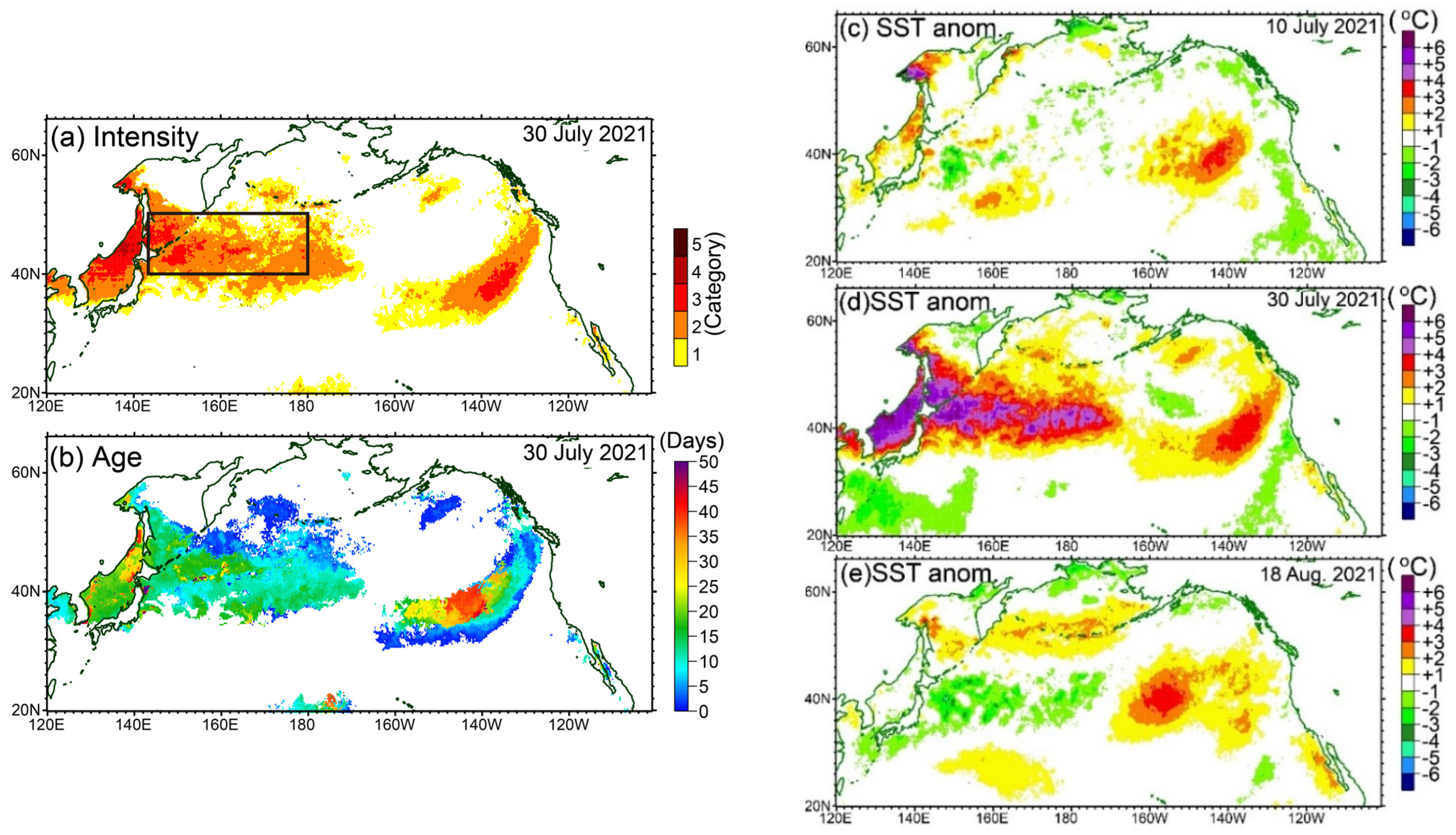
Figure ii. Time series of the daily SST anomaly (blueish lines, corresponding to the right blue axes) and MHW index (reddish lines, corresponding to the left red axes) during (a) 1982–2021 and (b) June–August 2021. The SST bibelot and MHW index were estimated at each grid bespeak and then spatially averaged over 143°E–180° and 40°–l°N (rectangle in Figure 1a). As indices for evaluating the variability of the daily SST anomaly, the +iii standard deviation line (dashed blue line) is shown in (a), and the daily SST anomaly normalized by the standard divergence at each filigree point and spatially averaged over the focal surface area (light-green line, respective to the right green centrality) is shown in (b).
Figure ii. Time series of the daily SST anomaly (blue lines, respective to the correct blue axes) and MHW alphabetize (cherry lines, corresponding to the left reddish axes) during (a) 1982–2021 and (b) June–August 2021. The SST anomaly and MHW index were estimated at each grid point and so spatially averaged over 143°E–180° and 40°–l°N (rectangle in Effigy 1a). As indices for evaluating the variability of the daily SST anomaly, the +three standard difference line (dashed blue line) is shown in (a), and the daily SST anomaly normalized by the standard divergence at each grid point and spatially averaged over the focal area (greenish line, respective to the right green axis) is shown in (b).

Figure 3. (a) Net heat flux anomalies (Qnet′) at the sea surface during 10–30 July 2021. (b) SST anomaly differences between 10 and 30 July 2021 (ΔSST′). The pink rectangle indicates the focal surface area (143°Due east–180°, 40°–50°North).
Figure three. (a) Net heat flux anomalies (Qnet′) at the ocean surface during x–30 July 2021. (b) SST anomaly differences between 10 and 30 July 2021 (ΔSST′). The pink rectangle indicates the focal expanse (143°E–180°, 40°–50°N).
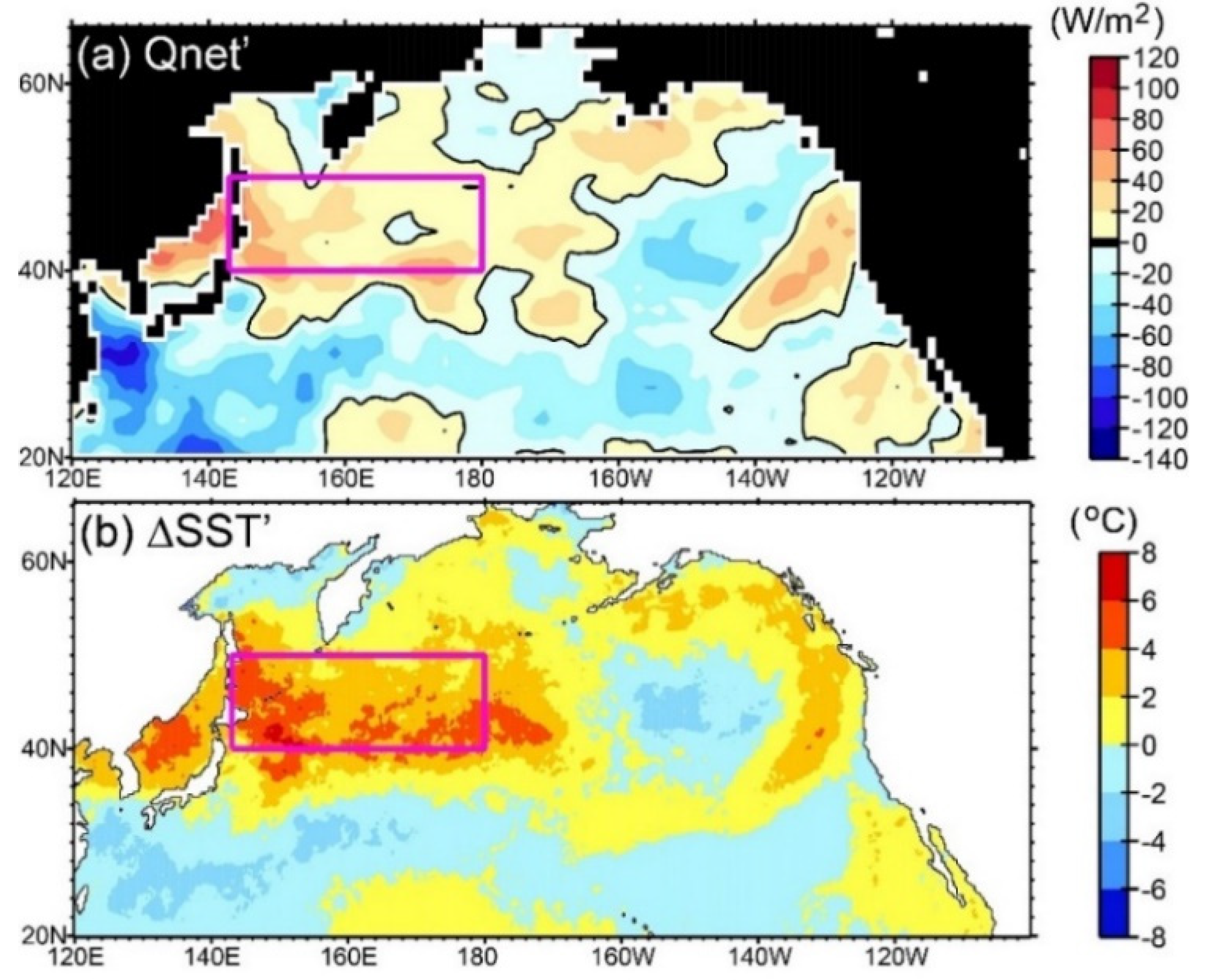
Figure 4. (a) Internet shortwave radiations, (c) internet longwave radiation, (e) latent heat, and (thou) sensible heat flux averaged over 10–30 July 2021. Anomalies of (b) net shortwave radiation, (d) net longwave radiation, (f) latent heat, and (h) sensible heat flux.
Effigy 4. (a) Cyberspace shortwave radiations, (c) internet longwave radiations, (e) latent heat, and (yard) sensible heat flux averaged over x–30 July 2021. Anomalies of (b) net shortwave radiation, (d) cyberspace longwave radiations, (f) latent heat, and (h) sensible heat flux.
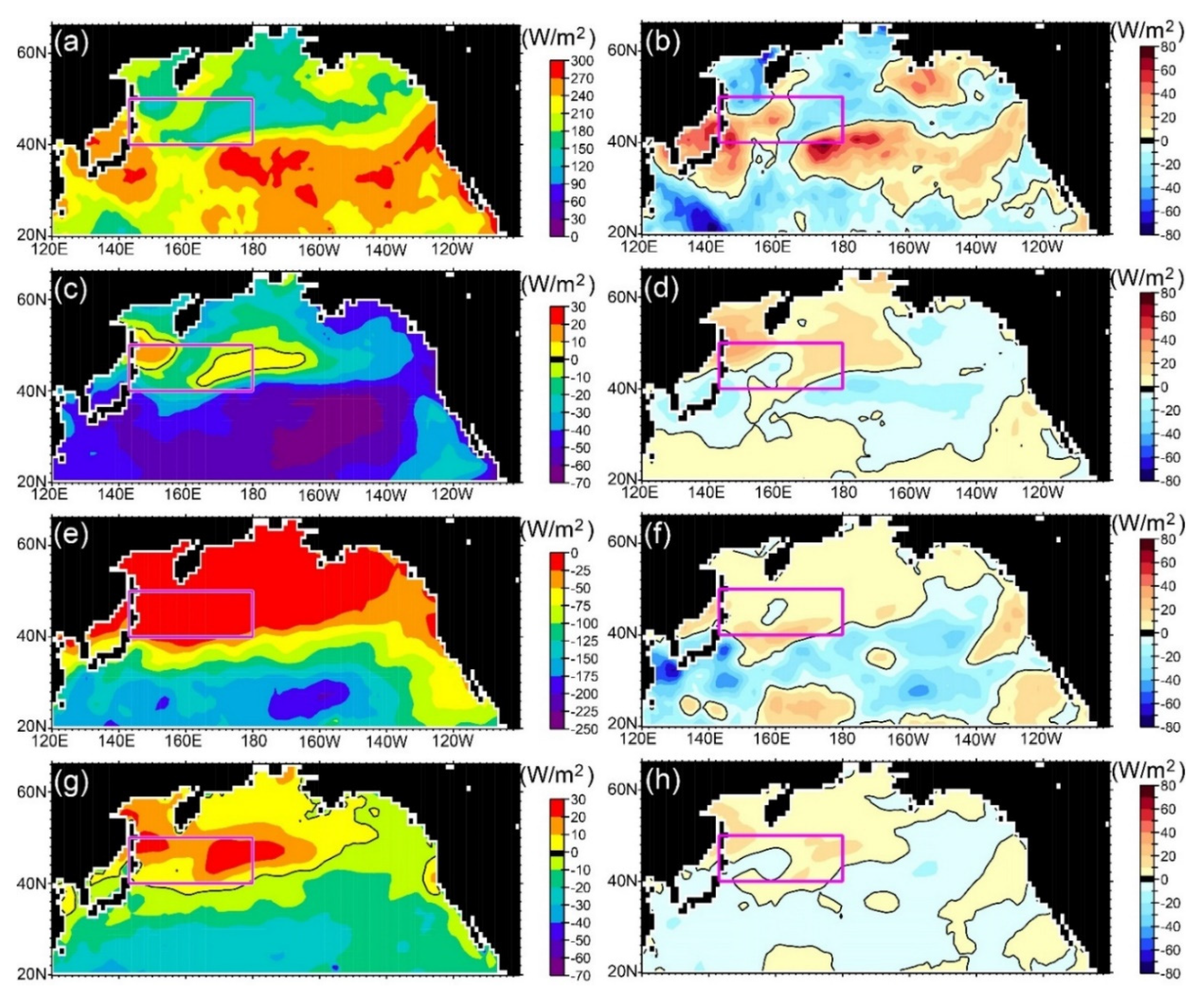
Effigy 5. Monthly seawater temperature anomalies at 20 chiliad below the ocean surface in (a) May, (b) June, and (c) July 2021. (d) Monthly time series of the temperature anomalies averaged over the focal area (143°East–180°, 40°–50°N). In (d), the calibration of the horizontal axis for the twelvemonth 2021 has been enlarged. The monthly subsurface temperature anomalies in 2021 are depicted past airtight circles connected past a assuming line.
Figure 5. Monthly seawater temperature anomalies at twenty k below the ocean surface in (a) May, (b) June, and (c) July 2021. (d) Monthly time series of the temperature anomalies averaged over the focal area (143°Eastward–180°, 40°–l°N). In (d), the scale of the horizontal axis for the twelvemonth 2021 has been enlarged. The monthly subsurface temperature anomalies in 2021 are depicted by closed circles connected by a bold line.
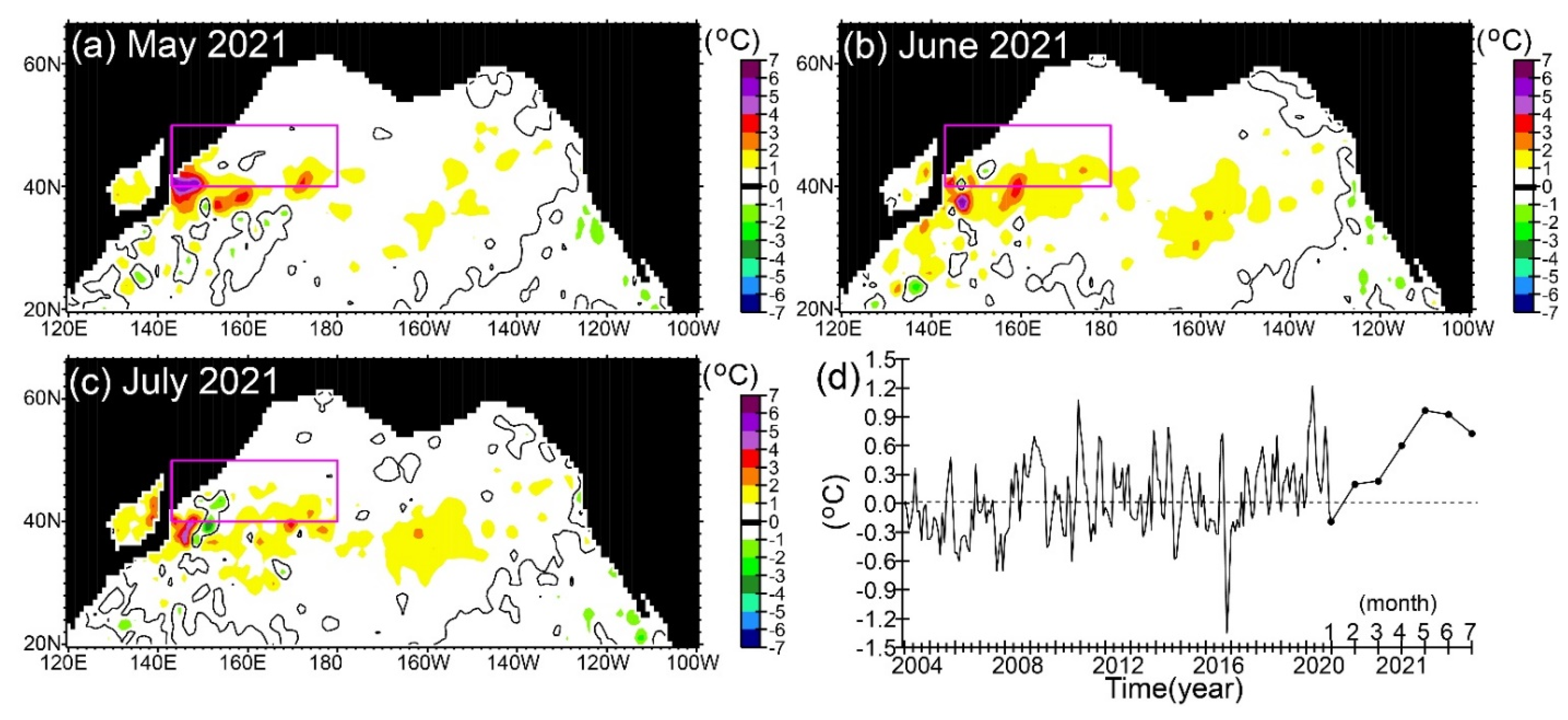
Figure six. (a) Thickness anomalies of the oceanic surface boundary layer during 10–30 July 2021, estimated past a mixed layer model based on K-profile parameterization in the 1/10° ocean apportionment model. Climatological means were estimated by averaging the thickness over 30 sensitivity simulations based on external forcings in 1990–2019. (b) Fourth dimension serial of oceanic surface purlieus layer thickness spatially averaged over the focal area (143°Eastward–180° and twoscore°–50°N; the purple rectangle in (a)). The bold black line shows the daily fourth dimension series in 2021. Open circles denote daily means of the 30 simulations. Blueish shading shows the 10th to 90th percentile range. Ruddy shading shows the range, beyond these percentiles, between the minimum and maximum.
Effigy 6. (a) Thickness anomalies of the oceanic surface boundary layer during 10–30 July 2021, estimated by a mixed layer model based on K-profile parameterization in the i/10° ocean circulation model. Climatological means were estimated by averaging the thickness over 30 sensitivity simulations based on external forcings in 1990–2019. (b) Fourth dimension serial of oceanic surface purlieus layer thickness spatially averaged over the focal area (143°East–180° and 40°–50°N; the purple rectangle in (a)). The bold black line shows the daily time series in 2021. Open up circles denote daily means of the 30 simulations. Blueish shading shows the 10th to 90th percentile range. Red shading shows the range, beyond these percentiles, betwixt the minimum and maximum.
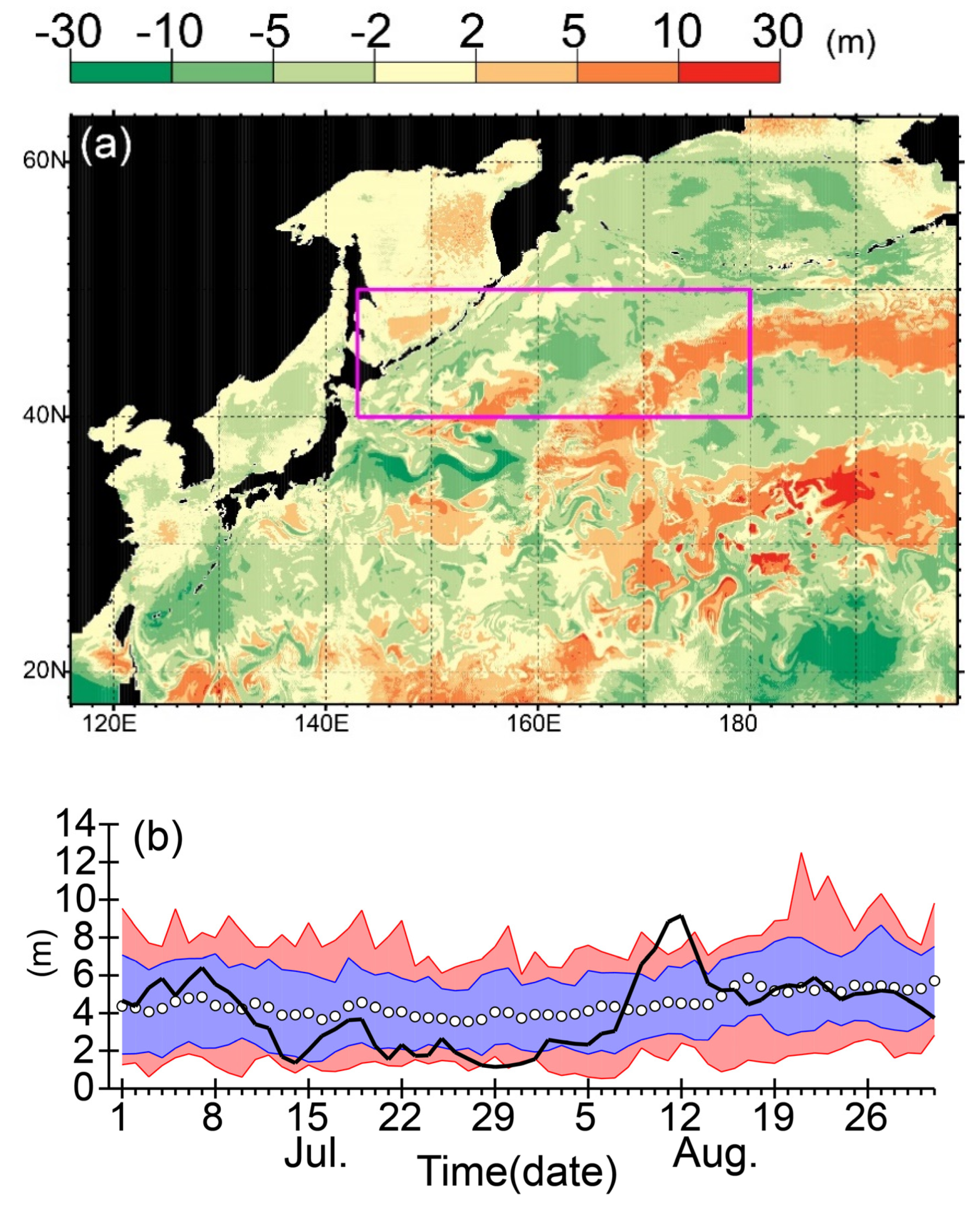
Figure 7. (a) Sea level pressure during ten–30 July 2021. Anomalies during 10–thirty July 2021: (b) bounding main level pressure level, (c) air temperature at 2 m to a higher place the body of water surface, (d) magnitude of wind stress at 10 k in a higher place the sea surface, (e) full cloud cover, and (f) depression cloud embrace.
Effigy seven. (a) Body of water level pressure during ten–30 July 2021. Anomalies during 10–thirty July 2021: (b) sea level pressure level, (c) air temperature at 2 m above the body of water surface, (d) magnitude of wind stress at 10 chiliad in a higher place the sea surface, (east) total deject encompass, and (f) low deject cover.
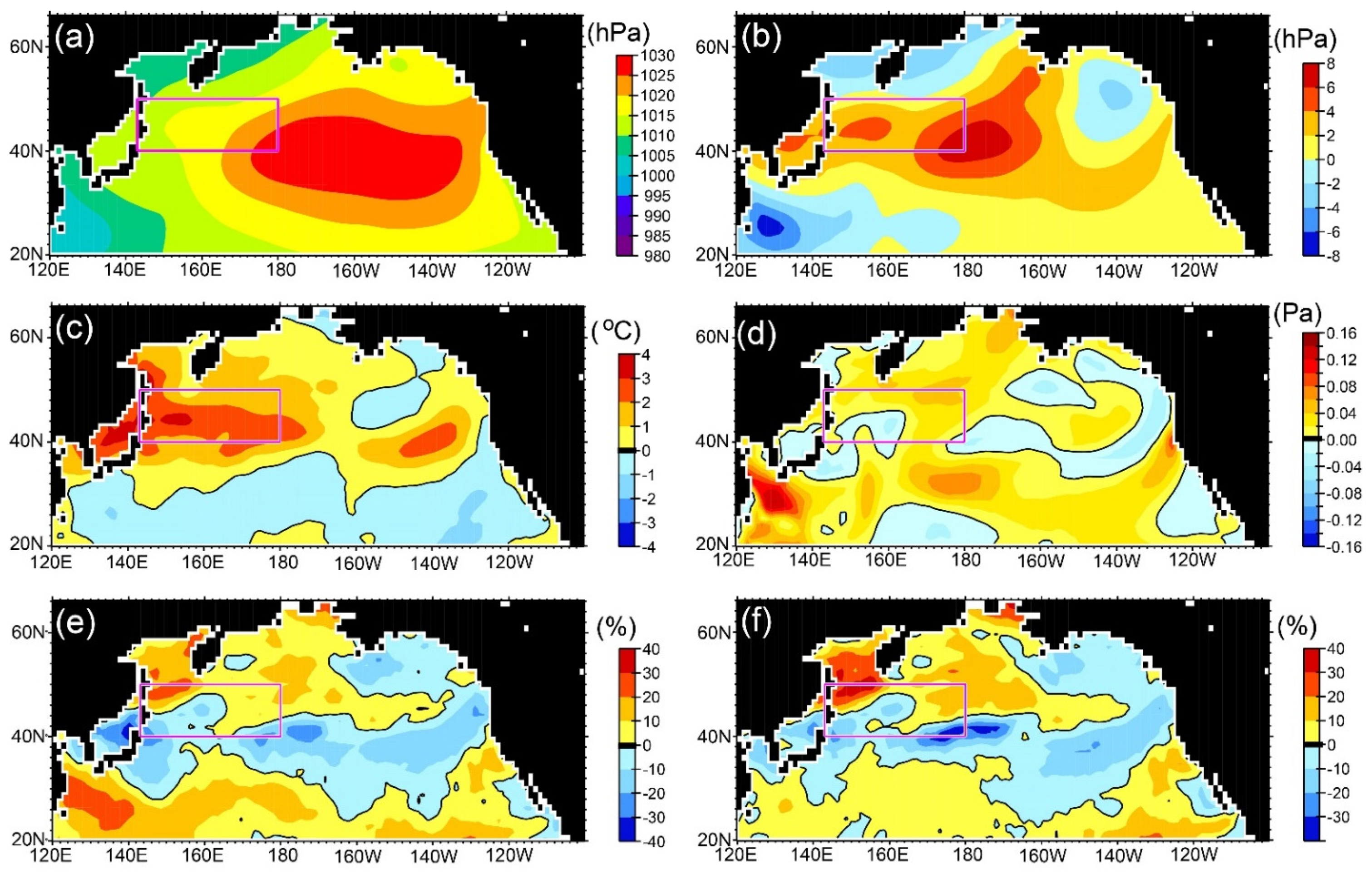
Figure 8. East wind velocity at 200 hPa averaged over 10–30 July (a) in 2021 and (b) 1990–2019. The purple rectangle indicates the focal area (143°E–180°, 40°–50°Due north). Strong velocities of >20 m s−1 are associated with the westerly jet.
Figure 8. Eastward wind velocity at 200 hPa averaged over ten–30 July (a) in 2021 and (b) 1990–2019. The majestic rectangle indicates the focal area (143°E–180°, twoscore°–l°N). Potent velocities of >20 m southward−1 are associated with the westerly jet.
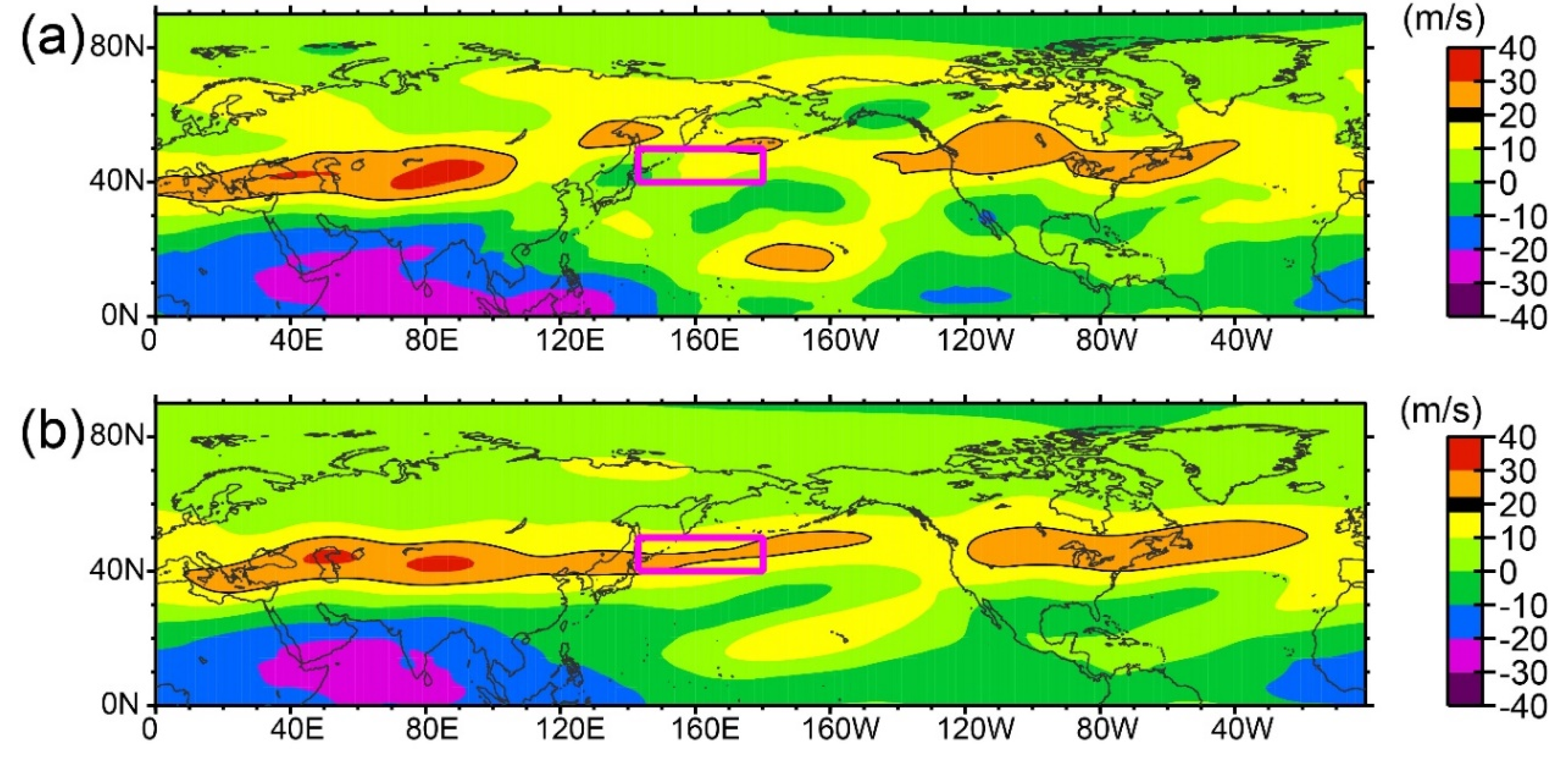
Figure ix. (a) Daily meridional position of the westerly jet axis during June–Baronial 2021. The jet centrality was divers every bit the velocity maximum at 200 hPa between xxx°N and 60°N. When the velocity maximum was at either 30°N or 60°Due north, the axis position was not specified (i.e., white areas). (b) Normalized anomalies of the centrality position. The daily hateful axis position (Y) was normalized by the 30-year daily mean (M) and the standard deviation (South): i.eastward., (Y – M)/S. The values of 50°Northward in panel (a) and 3 in panel (b) are emphasized by bold contours. The red dashed rectangle denotes the area within 143°E–180°.
Figure 9. (a) Daily meridional position of the westerly jet axis during June–Baronial 2021. The jet centrality was defined as the velocity maximum at 200 hPa between xxx°N and 60°N. When the velocity maximum was at either 30°N or lx°N, the axis position was not specified (i.e., white areas). (b) Normalized anomalies of the axis position. The daily mean axis position (Y) was normalized by the 30-year daily hateful (M) and the standard difference (S): i.due east., (Y – Thousand)/S. The values of 50°N in panel (a) and 3 in panel (b) are emphasized by bold contours. The ruddy dashed rectangle denotes the area within 143°E–180°.
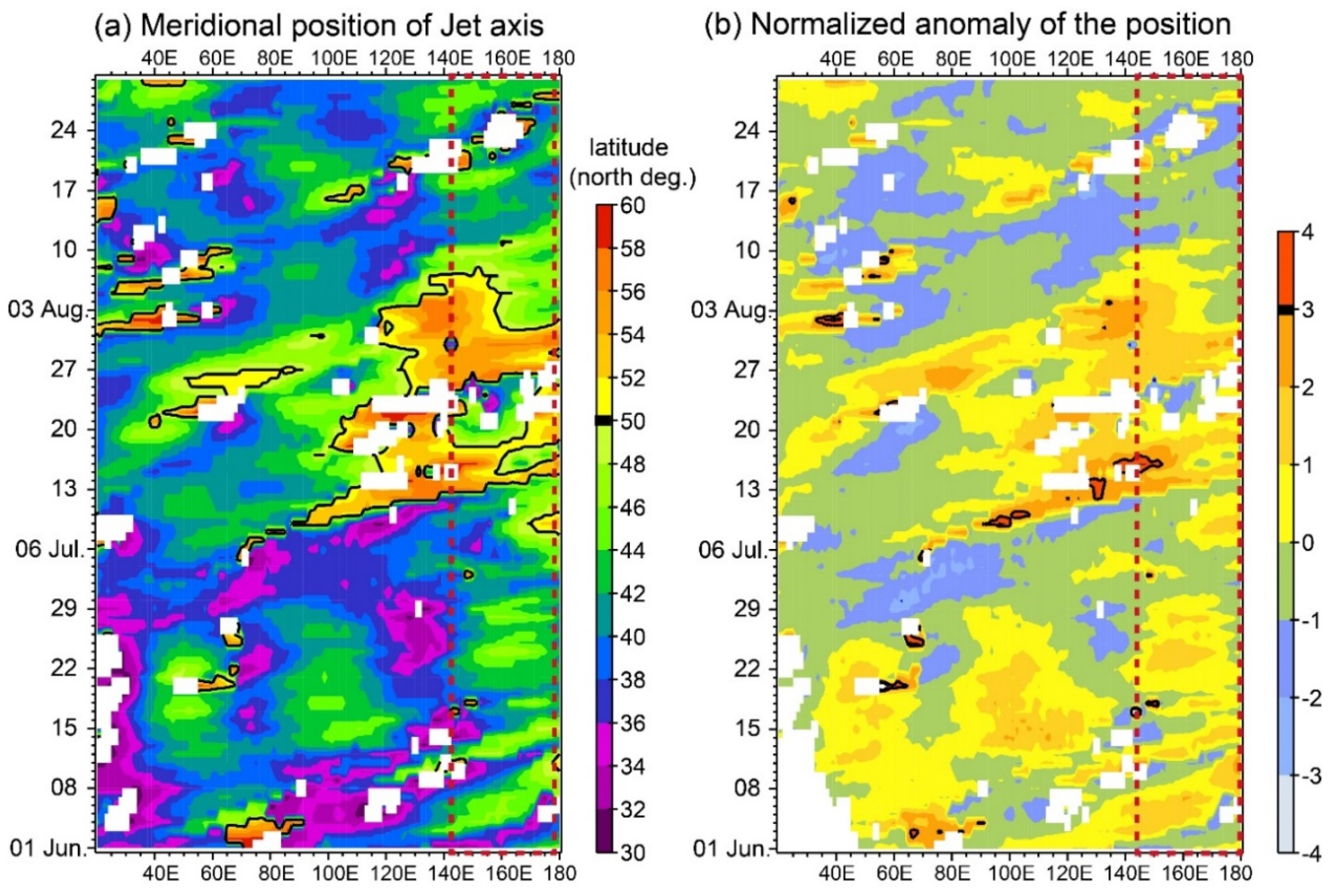
Figure 10. (a) Sea level pressure during 1–18 August 2021. Anomalies during the same period: (b) bounding main level pressure, (c) air temperature at 2 m to a higher place the sea surface, and (d) net heat flux at the sea surface.
Figure 10. (a) Sea level pressure during one–xviii August 2021. Anomalies during the same menses: (b) sea level pressure, (c) air temperature at 2 one thousand to a higher place the bounding main surface, and (d) net oestrus flux at the sea surface.
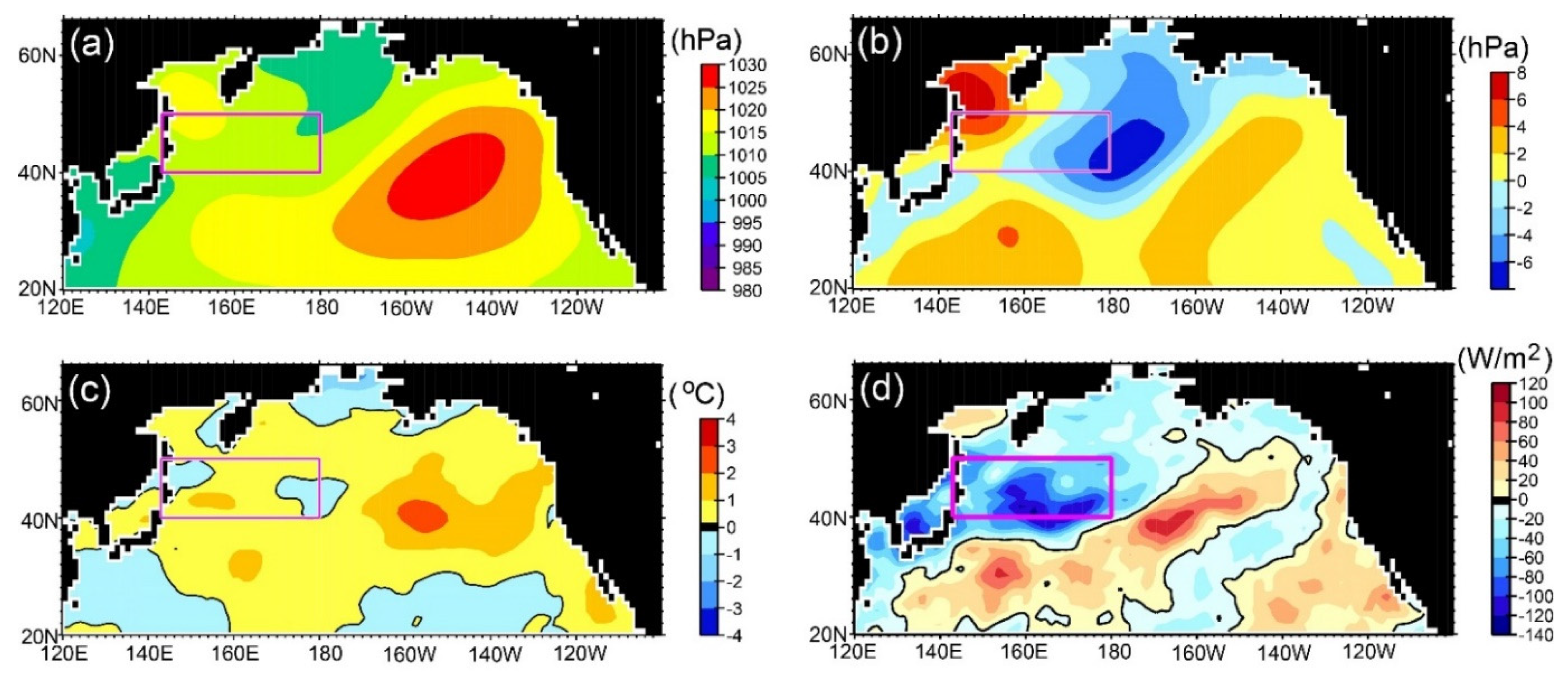
| Publisher's Note: MDPI stays neutral with regard to jurisdictional claims in published maps and institutional affiliations. |
© 2021 by the authors. Licensee MDPI, Basel, Switzerland. This article is an open up admission article distributed under the terms and conditions of the Creative Eatables Attribution (CC By) license (https://creativecommons.org/licenses/by/iv.0/).
Source: https://www.mdpi.com/2072-4292/13/19/3989/htm
0 Response to "Brpady Dfined Is the Art of Implemting That Leaves Mark on a Surface"
Post a Comment